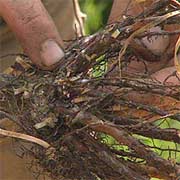Planting perennials and roses bare root can be daunting, especially when the plants arrive looking like a mass of brown roots and sticks. It is sometimes hard to know which end is up! But there are two reasons bare root is a good option - price and resilience.
Bare root plants are dug from the field while they are still dormant and shipped without any soil around the roots. They will arrive packaged in a plastic bag with a packing material that is slightly moist. This packing material can be sphagnum moss, wood shavings or even paper. This minimal packaging makes them easier to ship, which translates into a less expensive plant for you. And if you follow the design principle of abundance that I do - always plant in multiples of 3 - this is important.
Bare root plants are also quick to establish themselves in the garden. You don't have to worry about transplant shock associated with moving a plant from a container to a flowerbed. And even though they may not look like much, the plants you receive are likely to be larger than a comparable container grown plant.
Although you may order your plants in early spring, the company will hold your order until the appropriate planting time in your area. In northern regions this could be as late as early May. As soon as you receive your plants, take them out of the boxes and check that your order is correct and the plants are in good shape. The roots should be healthy and firm. A little bit of mold is okay, but they shouldn't be either dried up or too mushy.
Weather permitting, bare root plants should be planted immediately after arrival. Soak them for up to 5 hours to get them re-hydrated.
If you haven't already, pick a site for planting. Check the plant label and choose a location in your garden that matches the cultural requirements listed there.
For best results loosen the soil in the designated area to about 10 to 12 inches. Incorporate compost into the soil to aid in drainage and add nutrients.
Dig a hole that is 1.5 times as deep and wide as the plant's roots. Build a firm mound of soil in the middle of the hole. Spread the roots over the mound so that the crown sits at or just below the soil line. Gently back fill the hole. If you have top growth, pull the soil up around it just as you would a container grown plant otherwise cover the entire thing with a 1/2 inch of soil. Tamp the soil down and water well. Wait until growth begins to emerge to apply a layer of mulch. Keep the plant consistently moist through the growing season.
Of course, sometimes delays can't be avoided. You can store the plants inside their original packaging for a day or two in a cool, dark place. Just don't let them freeze.
A longer-term alternative is to heel the plants in. Dig a trench in the garden, remove the plants from their packaging and lay them on their sides with their roots in the trench. Cover the roots with soil and water well until conditions are right to plant them in their permanent location.
Tuesday, February 15, 2011
Thursday, February 10, 2011
Wednesday, February 9, 2011
Is it too early to think spring plant sale
Save $7.00 off first plant flat/tray or bulk unit of bare root plants, plus lots of individual plant specials too!
For $7.00 Coupon code - NoSnow must be entered at check out.
Promotion ends February 15, 2011. Offer valid online only, cannot be combined with any other coupons or promotions and may change, be modified or cancelled at anytime without notice. Shipment date may be subject to availability, and quantities are limited.
Website choices include:
achillea, aconitum, actinidia, adenophora, aegopodium, agastache, ajuga, alcea, alchemilla, allium, alstroemeria, ampelopsis, amsonia, anemone, anthemis, aquilegia, arabis, ardisia, arenaria, aristolochia, armeria, artemisia, aruncus, asarum, asclepias, aster, astilbe, aubrieta, aurinia, baptisia, belamcanda, bergenia, boltonia, brunnera, buddleia, campanula, campsi, caryopteris, catananche, centaurea, centranthus, cerastium, ceratostigma, chelone, chrysogonum, cimicifuga, clematis, convallaria, coreopsis, corydalis, crocosmia, delosperma, delphinium, dianthus, dicentra, dictamnus, digitalis, doronicum, echinacea, echinops, epimedium, erigeron, euonymus, eupatorium, euphorbia, fallopia, ferns, ficus p. creeping fig, filipendula, fragaria, gaillardia, galium, gaura, geranium, geum, gypsophila, hedera, helianthus, heliopsis, helleborus, heuchera, heucherella, hibiscus, houttuynia, humulus l. ureus, hypericum, iberis, iris, kniphofia, lamiastrum, lamium, lantana, lathyrus latifolius, laurentia f., lavandula, leucanthemum, lewisia, liatris, ligularia, limonium, linum, liriope, lobelia, lupinus, lychnis, lysimachia, macleaya, malva, mazus, molinia, monarda, myosotis, nepeta, oenothera, origanum, pachysandra, paeonia, papaver, parthenocissus, penstemon, perovskia, persicaria, phlox, physostegia, platycodon, polemonium, polygonatumo, polygonum aubertii, potentilla, primula, pulmonaria, pulsatilla, ranunculus, rodgersia, rubus calycinoides, rudbeckia, sagina, salvia, saponaria, scabiosa, schizophagma, sedum, sempervivum, sidalcea, sisyrinchium, stachys, stokesia, tanacetum, teucrium, thalictrum, thymus, tiarella, trachelospermum asiaticum, tradescantia, tricyrtis, trollius, verbena, veronica, vinca, viola, yucca, or
Ornamental grasses including acorus, arrhenatherum, calamagrostis, carex, chasmanthium, cortaderia, erianthus, festuca, glyceria, hakonechloa, helictotrichon, miscanthus, ophiopogon, panicum, pennisetum, phalaris, schizachyrium, or
from hundreds of hemerocallis and hosta.
Subscribe to:
Posts (Atom)



